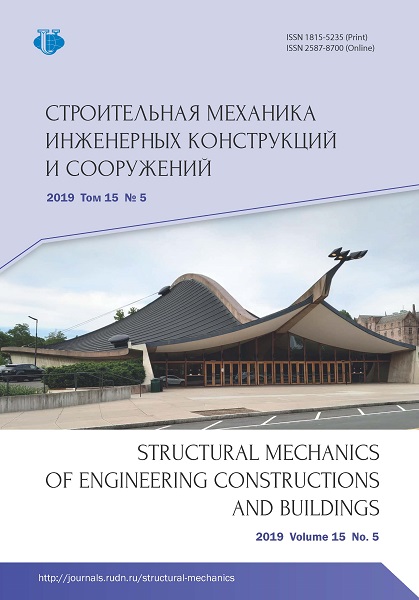The use of fixed points in experimental research of the internal friction of material
- Authors: Zylev V.B.1, Platnov P.O.1
-
Affiliations:
- Russian University of Transport
- Issue: Vol 15, No 5 (2019)
- Pages: 399-404
- Section: Experimental researches
- URL: https://journals.rudn.ru/structural-mechanics/article/view/22364
- DOI: https://doi.org/10.22363/1815-5235-2019-15-5-399-404
Cite item
Full Text
Abstract
The aim of the work. The work is devoted to experimental research of internal friction parameters of the material. Methods. The research of internal friction is carried out by consideration of damped oscillations of the experimental system that consist of rigid plates and a specimen in a state of pure bending. We propose to locate bearings in the fixed points to minimize energy losses in support fastenings. Fixed points are determined by using a finite element complex with consideration of free oscillations of the loose model. Results. Damping curves were determined, which demonstrate a very small logarithmic decrement of oscillations and frequency independence of inertial friction. The main result of the work is the tested improvements of the experimental technique, among which the main one is the use of fixed points for determining the places of fastening of the laboratory installation
About the authors
Vladimir B. Zylev
Russian University of Transport
Author for correspondence.
Email: manuntdfan@mail.ru
Doctor of Science (Technical), Professor, Head of the Department of Structural Mechanics
9 Obraztsova St., Moscow, 127994, Russian FederationPavel O. Platnov
Russian University of Transport
Email: manuntdfan@mail.ru
PhD student of the Department of Structural Mechanics
9 Obraztsova St., Moscow, 127994, Russian FederationReferences
- Velikanov N.L., Naumov V.A., Koryagin S.I. (2017). Vnutrennee trenie pri prodol'nyh kolebaniyah trosa [The internal friction in longitudinal oscillations of the wire rope]. Journal of I. Kant Baltic Federal University. Series: Physical, Mathematical and Technical Sciences, (3), 84–92. (In Russ.)
- Read T.A. (1940). The internal friction in single metal crystals. Physical review, 58, 371–380.
- Vronskaya E.S. (2017). Dinamicheskij raschet prizmaticheskih sistem s uchetom vnutrennego treniya [Dynamic calculation of prismatic systems taking into account internal friction]. Urban planning and architecture, (3), 24–27. (In Russ.)
- Khromov V.G., Khromov I.V., Khromov E.V. (2016). Metodika opredeleniya integral'nogo koefficienta vnutrennego treniya dlya poperechnyh kolebanij sterzhnya [Method of determining integral coefficient of internal friction for transverse vibrations of a rod]. Fundamental and applied problems of engineering and technology, (3), 3–7. (In Russ.)
- Veshkin M.S., Grebenyuk G.I. (2019). Ob ispol'zovanii kompleksnoj modeli vnutrennego treniya v raschetah sterzhnevyh sistem na impul'snye vozdejstviya [On the use of the complex model of internal friction in calculation of rod systems on pulse impacts]. Proceedings of Higher Educational Institutions. Construction, (5), 5–17. (In Russ.)
- Senitskiy Y.E. (2017). Ob uchete sil vnutrennego treniya v nestacionarnyh zadachah dinamiki [About the account of internal friction forces in non-stationary problems of dynamics]. Traditions and Innovations in Construction and Architecture. Natural Sciences and Technosphere Safety (pp. 182–186). (In Russ.)
- Novick A.S. (1950). Variation of amplitude-dependent internal friction in single crystals of copper with frequency and temperature. Physical review, 80(2), 249–257.
- Khromov O.V. (2009). Eksperimental'noe issledovanie harakteristik vnutrennego treniya stal'nyh spiral'nyh kanatov i provoloki [Experimental research of internal friction characteristics of steel spiral ropes and wires]. Proceedings of Odessa Polytechnic University, (1), 32–35. (In Russ.)
- Platnov P.O. (2018). Eksperiment po proverke chastotnoj nezavisimosti vnutrennego treniya [Experimental verification of the frequency independence of internal friction]. Postgraduate recitations: collection of scientific articles of RUT postgraduates (pp. 66–70). (In Russ.)
- Zylev V.B., Grigor’ev N.A. (2011). Obobshchennaya model' Prandtlya dlya ucheta sil vnutrennego treniya [Generalized Prandtl model for the account of internal friction forces]. Construction mechanics and calculation of structures, (11), 58–62. (In Russ.)
- Davidenkov N.N. (1938). Obzor o rasseyanii energii pri vibratsiyakh [Overview of energy dissipation in vibrations]. Journal of Technical Physics, 8(6), 483–499. (In Russ.)
- Pisarenko G.S. (1955). Kolebaniya uprugih sistem s uchetom rasseyaniya energii v materiale [Oscillations of elastic systems taking into account the energy dissipation in the material]. Kiev: Akademiya nauk Ukrainskoj SSR Publ. (In Russ.)
- Sorokin E.S. (1951). Metod ucheta neuprugogo soprotivleniya materiala pri raschete konstruktsii na kolebaniya [Method of accounting for inelastic resistance of the material in the calculation of structures under vibrations]. Research on the dynamics of structures (pp. 5–90). (In Russ.)
- Sorokin E.S. (1960). K teorii vnutrennego treniya pri kolebaniyah uprugih sistem [On the theory of internal friction at oscillations of elastic systems]. Moscow: Gosstroyizdat Publ. (In Russ.)
- Panovko Ya.G. (1960). Vnutrennee trenie pri kolebaniyah uprugih sistem [The internal friction at oscillations of elastic systems]. Moscow: Izdatel'skij dom fizikomatematicheskoj literatury Publ. (In Russ.)
















